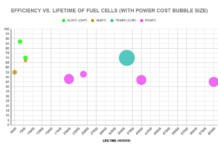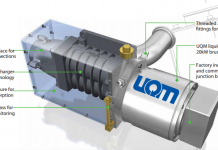By Jeff Siegel
It was boasted as an energy breakthrough.
Bloom Energy’s Bloom Box paraded around the media including a very generous piece aired by 60 Minutes as some kind of new, game-changing magical energy creation device that would change the world.
Problem is, it’s not really “new.” And it’s certainly not going to change the world.
But don’t tell that to the folks who are looking to take the company public, perhaps as soon as this year.
Now, I’m not saying a Bloom Energy IPO would fail. In fact, based on the hype surrounding the company, I imagine it would do quite well. And as far as getting these things in the field, Bloom has been more successful than any other fuel cell company before it.
But is that enough to justify all the praise?
When Gas Heads North
Bottom line: Bloom Energy is fuel cell company, no matter how anyone tries to spin it.
 Bloom Energy Servers debut at eBay headquarters in San Jose, CA. Photo by Jakub Mosur |
Bloom’s distinguishing advantage, however, is its fuel flexibility.
In other words, it’s not dependent upon one resource, unlike most other fuel cell manufacturers that are married to hydrogen. And with natural gas so cheap these days, it certainly makes the economics of Bloom a lot more attractive.
The question is, how long can that last? Moreover, will dirt-cheap natural gas actually impede growth in the near term?
While the news keeps getting better and better for natural gas reserve numbers, the debate over decline rates continues. And the truth is no one really knows how steep the decline rates are for these shale gas wells.
But there’s plenty of data that suggest it could be a lot worse than industry cheerleaders and bureaucrats are letting on…
As oil and gas expert Chris Nelder wrote last year:
… the decline rates of shale gas wells are steep. They vary widely from play to play, but the output of shale gas wells commonly falls by 50% to 60% or more in the first year of production. This is why I have called it a treadmill: you have to keep drilling furiously to maintain flat output.
In the U.S., the aggregate decline of natural gas production from both conventional and unconventional sources is now 32% per year, so 22 bcf/d of new production must be added every year to keep overall production flat, according to Canadian geologist David Hughes. That’s close to the total output of U.S. shale gas, after nearly a decade of its development. It will require thousands more shale gas and tight oil wells to keep domestic gas production flat.
One way or another, natural gas prices are going to head north again whether it’s because of rapid decline rates, a transition of our trucks and buses to run on natural gas, or the export of our bounty to other nations that are wiling to pay five times as much for it.
So at the end of the day, for the sake of long-term planning, we simply can’t ignore the inconvenient truth of finite resources. Or maybe we can. Certainly we’ve been doing it for years.
For consumers, this is a constant headache. For investors, however, it’s a mentality that can make you rich.
But how does this affect Bloom’s growth prospects?
When the Grid Is Down
The Bloom Box can use natural gas as a fuel, as well as a number of other fuels, including methane.
But when using cheap natural gas, Bloom’s fuel cells allow us to stretch out our already abundant supply of natural gas while allowing the company to provide a more profitable distributed generation solution.
Though when we do finally see natural gas prices head north again, which I believe will be sooner than later, it will become harder for the economics to make sense, not to mention incentives that exist today won’t be around forever.
Of course, from a practicality standpoint, the biggest advantage to a system like the Bloom Box is its ability to provide uninterrupted power.
You see, Bloom and other fuel cell manufacturers often make the claim that these systems serve as safety mechanisms that allow homes and businesses to operate when the grid is down something that is going to happen more and more as the intensity and extremity of weather events become more common.
My friends, there is some real value to this.
And in an effort to combat a future of increased extreme weather events, distributed generation is a must…
Microgrids, fuel cells, rooftop solar all of this stuff can serve as a hedge against the fallout from extreme weather events and supply disruptions. Although I have to admit, strictly from a reliable form of power generation when the grid goes down, I’m more fond of solar. The economics are better right now and there is no requirement to “feed” the system.
In comparison, the Bloom Box relies on a direct fuel source which will most likely come in the form of a finite resource that carries with it price fluctuations. And if, for some reason, that supply is disrupted… well, you’re out of luck.
That’s not to say the Bloom Box doesn’t have its advantages over solar. Certainly if there is no supply disruption, you get 24-hour power generation, whereas solar will leave you high and dry when it gets dark out assuming you don’t have backup storage already in place, which most don’t.
In any event, I suspect fuel cell manufacturers like Bloom do have a future. In the near term, however, I’m convinced the dual threat of cheap natural gas and overall complacency on the part of individuals and governments will result in limited interest.
That being said, because Bloom is expected to hit profitability this year and it seems to get about as much publicity as Lindsay Lohan at a strip club I would certainly be interested in wetting my beak on the first day of a Bloom Energy IPO, then trade it a bit on hurricane and storm warnings.
As more develops on this Bloom Energy IPO, we’ll keep you posted.
To a new way of life and a new generation of wealth…

Jeff Siegel is Editor of Energy and Capital, where this article was first published.







